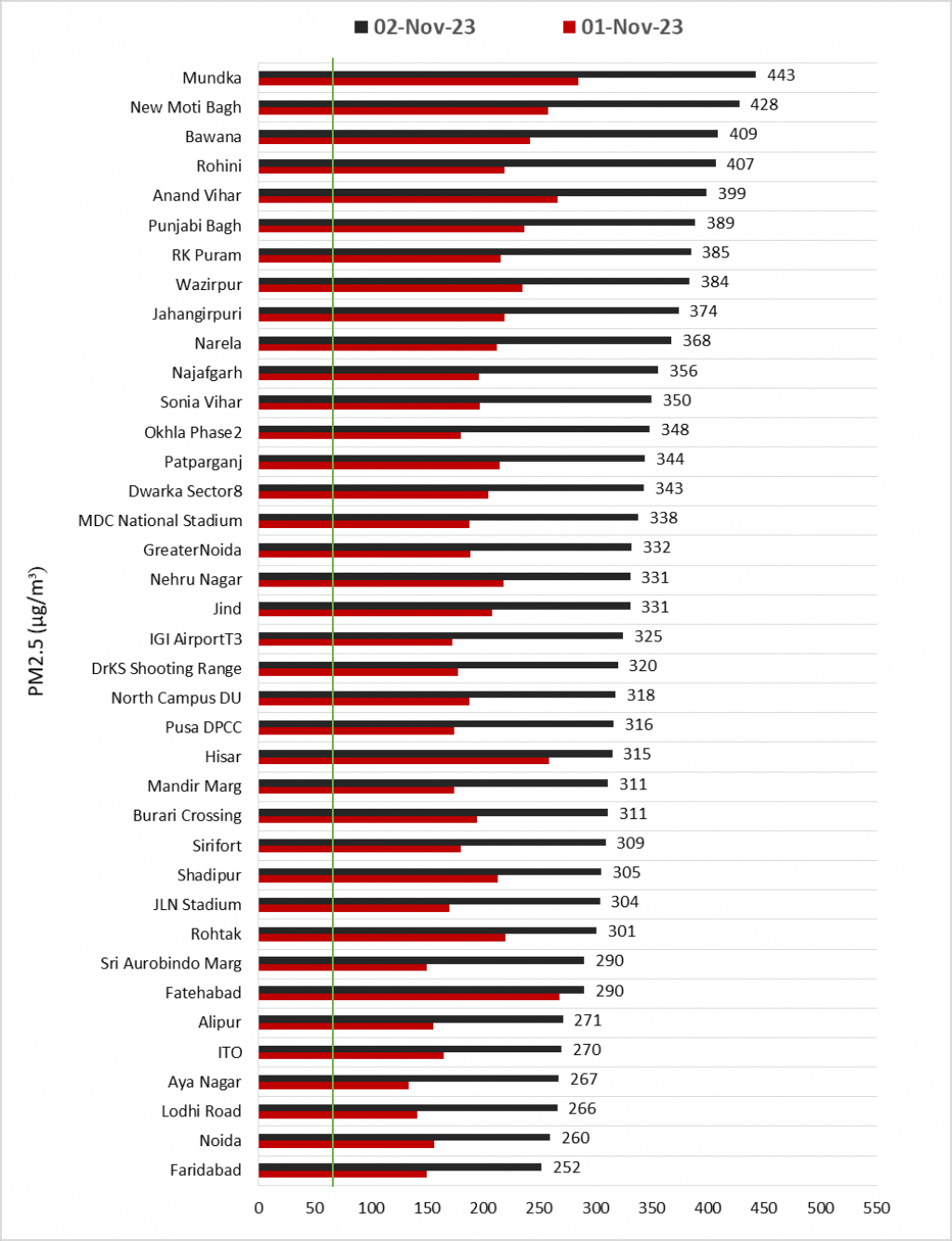

About 25% of PM2.5 on November 2 could be from farm stubble burning



Once again, the national capital region of India finds itself ensnared by the familiar, noxious grip of severe air pollution. In recent days, Delhi-National Capital Region’s (NCR) air quality has further deteriorated, breaching the alarming ‘400’ danger mark on the Air Quality Index (AQI) scale of 500. The maximum PM2.5 level in Mundka was over seven times higher than the 24-hour Indian standard and 30 times the World Health Organization (WHO) safe standard.
The escalating levels of pollutants, primarily fine particulate matter 2.5 (PM2.5), which can penetrate deep into the respiratory system, have pushed the air quality in the region into the ‘severe category’, significantly impacting the overall air quality.
On November 2, 2023, the PM2.5 concentration soared to alarming levels, pushing the region’s air quality from ‘poor’ to ‘very poor’. It eventually crossed the ‘400’ mark on the AQI scale and the PM2.5 concentration also crossed the 400 micrograms per cubic metre (µg/m³) level.
Read more: Delhi PM2.5 levels rose by 68 per cent within a day in early November: CSE
Air in the ‘good’ category (1-50) on the AQI has PM2.5 concentration less than 30µg/m3; ‘satisfactory’ category (51-100 AQI) PM2.5 concentration is 30-60µg/m3; ‘moderate’ (101-200 AQI) has 60-90µg/m3 PM2.5; ‘poor’ category (201-300 AQI) PM2.5 concentration is 90-120µg/m3; ‘very poor’ (301-400 AQI) is 120-250µg/m3 PM2.5 and ‘severe’ category (401-500) is over 250 µg/m3 for PM2.5.
Since the evening of November 2, the concentration of PM2.5 has reached ‘severe’ levels, pushing the overall air quality into the ‘severe’ category.
According to the WHO air quality guidelines, the annual average concentrations of PM2.5 should not exceed 5 µg/m3, while 24-hour average exposures should not exceed 15 µg/m3.
PM2.5 refers to ultrafine particles or droplets in the air that are 2.5 micrometres or smaller in size. These particles are a major component of air pollution and are notorious for their ability to penetrate deep into the lungs and even enter the bloodstream, causing a wide range of health issues. The worsening concentration of PM2.5 in the region is a major contributor to the declining air quality.
With PM2.5 concentrations plunging into the ‘severe’ category, it's evident the air quality in Delhi-NCR has reached a critical point, demanding immediate attention and decisive action. This level of pollution poses immediate risks to residents, especially vulnerable groups like children, the elderly, and individuals with pre-existing health conditions.
The Indo-Gangetic Plains mainly comprises five states: Punjab, Haryana, Uttar Pradesh, Bihar and West Bengal. The IGP is divided into four major subregions as per the erstwhile Planning Commission’s agro-climatic zones.
An analysis by the Delhi-based think tank Centre for Science and Environment (CSE) for the TGP area has revealed concerning data regarding PM2.5 concentrations. On November 1, 2023, the region recorded a maximum PM2.5 concentration of 285 µg/m³.
However, on November 2, 2023, the situation took a dramatic turn, with PM2.5 levels spiking significantly in many stations across Delhi-NCR. In fact, the maximum PM2.5 level recorded in the Mundka area reached an alarming 443 µg/m³, which is 7.4 times higher than the 24-hour Indian standard and 30 times the WHO safe standards.
Other areas that were severely affected include New Moti Bagh at 428 µg/m³, Bawana at 409 µg/m³ and Rohini at 407 µg/m³.
The PM2.5 concentration kept on increasing. On November 5, the highest PM2.5 concentration was recorded at Wazirpur at 465 ug/m3, while on November 6, it is 508 ug/m3 at Anand Vihar (Data till 12:00 pm). Overall PM2.5 concentration for Delhi was 337ug/m3 on November 5, 2023.
Read more: Deadly nursery: Children queue in hospitals with respiratory problems as Delhi air turns toxic
The spatial distribution of PM2.5 levels in the TGP area clearly illustrates the devastating dispersion across the Delhi-NCR. According to the Indian Institute of Tropical Meteorology, a significant portion of this pollution, approximately 25 per cent, on November 2, can be attributed to smoke coming from farm stubble burning.
This percentage can be further escalated to as high as 35 per cent. These factors have once again plunged the city into the throes of severe air pollution, with PM2.5 levels surging beyond 400 µg/m³.
Spatial distribution of PM2.5 concentration across TGP

A closer look at the data reveals that all 12 cities within Delhi have PM2.5 concentration levels exceeding 350 µg/m³. Greater Noida ranked 17th in the list with a PM2.5 level of 332 µg/m³, while Faridabad and Noida were not far behind, registering levels of 252 µg/m³ and 260 µg/m³, respectively.
Trend in PM2.5 level in TGP cities on November 1 and November 2, 2023

Source: CSE analysis of CPCB real-time data
The current state of air quality in Delhi-NCR is a matter of public health and environmental concern. Urgent and sustained efforts are needed to tackle the sources of pollution and mitigate the consequences.
As the region grapples with deteriorating air quality, it is imperative that government authorities and citizens work together to address this crisis, ensuring that clean and breathable air becomes a reality, not just a fleeting hope for the residents of Delhi-NCR.
Read more:
We are a voice to you; you have been a support to us. Together we build journalism that is independent, credible and fearless. You can further help us by making a donation. This will mean a lot for our ability to bring you news, perspectives and analysis from the ground so that we can make change together.

Comments are moderated and will be published only after the site moderator’s approval. Please use a genuine email ID and provide your name. Selected comments may also be used in the ‘Letters’ section of the Down To Earth print edition.